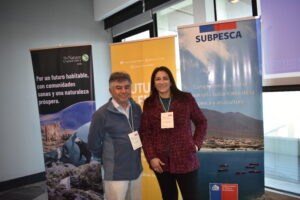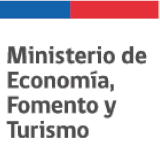
 The international workshop “Advancing Electronic Fisheries Monitoring in Chile” was held on September 9 and 10. It was organized by the National Fisheries and Aquaculture Service (Sernapesca) and the Undersecretariat of Fisheries and Aquaculture (Subpesca) with support from Future of Fish and The Nature Conservancy (TNC) to evaluate the current electronic monitoring monitoring, control, and supervision program for the industrial fleet and prepare for its incorporation in a segment of the artisanal sector in certain fisheries.
The international workshop “Advancing Electronic Fisheries Monitoring in Chile” was held on September 9 and 10. It was organized by the National Fisheries and Aquaculture Service (Sernapesca) and the Undersecretariat of Fisheries and Aquaculture (Subpesca) with support from Future of Fish and The Nature Conservancy (TNC) to evaluate the current electronic monitoring monitoring, control, and supervision program for the industrial fleet and prepare for its incorporation in a segment of the artisanal sector in certain fisheries.
The electronic monitoring system, which incorporates the installation of onboard cameras, has been operating since 2020 in 100% of the industrial fleet and is complemented by a series of fishing activity recording and monitoring tools to monitor regulatory compliance associated with operations in authorized areas, discards, and bycatch, among other issues. The incorporation of the artisanal fleet with vessels over 15 meters in length is planned for 2026, working in the fisheries of swordfish, cod, and pelagic species such as horse mackerel, sardines, and anchovies.
The national director of Sernapesca, Soledad Tapia Almonacid, explained that the objective of the workshop focused on “informing what electronic monitoring means, showing the results we have had throughout its implementation in recent years, which have been very successful, and also to clarify any doubts for all sector stakeholders, so that they can share and discuss the challenges, explore the available technologies, and also learn about other international experiences applied with the same objective.”
For his part, the Undersecretary of Fisheries and Aquaculture, Julio Salas, addressed the importance of electronic monitoring for resource sustainability: “We must base our decisions on robust, transparent, and verifiable information. Electronic monitoring provides us with a foundation of scientific and technical evidence that strengthens management and governance, and is also a decisive tool in the fight against Illegal, Unreported, and Unregulated Fishing.”
The event provided a platform for learning about local and international experiences with presentations by industry representatives and artisanal fishers, who discussed the factors that facilitated its implementation, as well as the challenges that remain to be addressed to improve its application.
Electronic monitoring providers also participated in the event to consider alternatives based on new technological advances developed in recent years, which would optimize currently used systems and address gaps such as data storage, transmission, and image analysis.
Integration and Collaboration
Natalio Godoy, leader of TNC Chile’s Oceans Strategy, commented, “For several years, we have been supporting critical pillars for fisheries sustainability and biodiversity conservation through collaboration agreements with both Sernapesca and Subpesca. In this context, electronic monitoring is a fundamental tool not only in terms of oversight but also for biodiversity conservation. We believe that collaboration is a fundamental part of advancing maritime conservation and fisheries management, and we are very pleased to be supporting this institutional framework.”
For his part, Diego Undurraga, Director of the Future of Fish Foundation, added: “These have been very interesting sessions, with representatives from many sectors, where we were able to discuss the Chilean context, what the successes and pending challenges have been. We also had international speakers to share experiences, learn from other models, and see how to continue improving the design for the great challenge of incorporating the artisanal fleet into the electronic monitoring program and, in turn, improve the existing program for the industrial fleet.”
The meeting featured international speakers who provided insight into the experience of electronic monitoring and fisheries data analysis applied in countries such as New Zealand, the United States, and Canada, from fishers, suppliers, and analysts.
The workshop also incorporated an academic perspective with the presentation of the results of a study funded by the Fisheries and Aquaculture Research Fund (FIPA) on Electronic Monitoring in Chile, led by researchers M. José Pérez and Maritza Sepúlveda. The study focused on the design of management of information recorded by image recording devices and data from electronic fishing logbooks.
In this regard, Gonzalo Pereira, executive director of the Fisheries Development Institute (IFOP), concluded that “The theme of this event is the electronic monitoring of fishing activity, which has been gradually implemented in Chile as an initiative to regulate and understand discards and bycatch, based on a new approach that was quite innovative from an oversight perspective, but which over the years has been finding new uses and new contributions, which interest us as IFOP, such as research.”
Press related links




